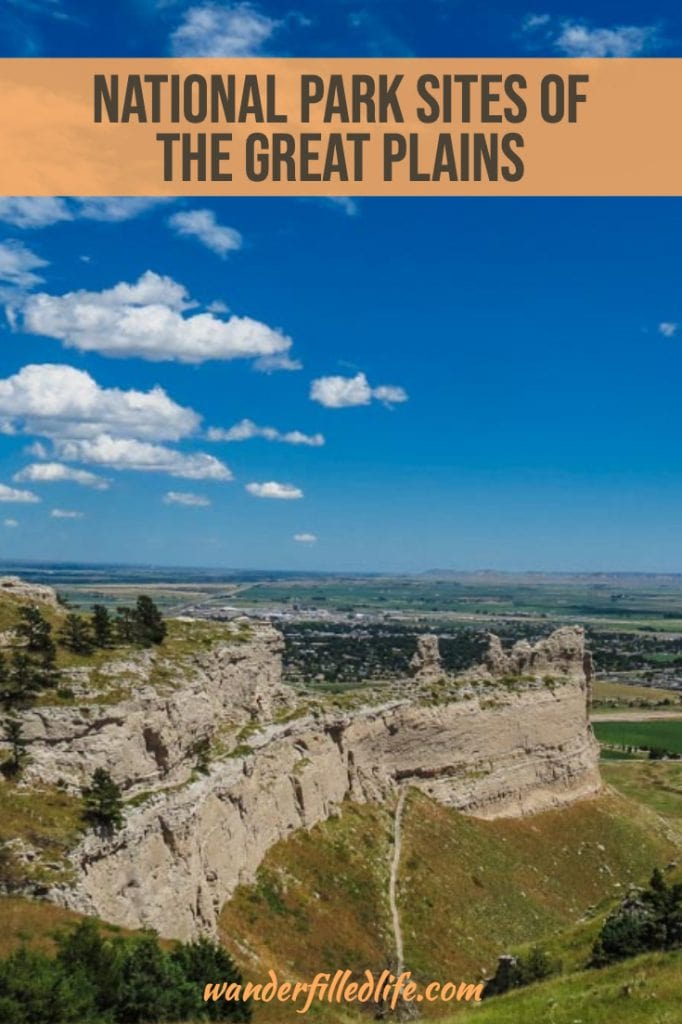Last Updated on February 22, 2024 by Grant
There’s a reason folks refer to the states in the middle of the country as “flyover states.” The states of the Plains are typically flat with a lot of corn fields, ranches and not a lot else of interest… at least at first glance.
When you dig deeper, get off the beaten path and really look around, you will find the history, culture and scenery of the Plains has a beauty all its own.
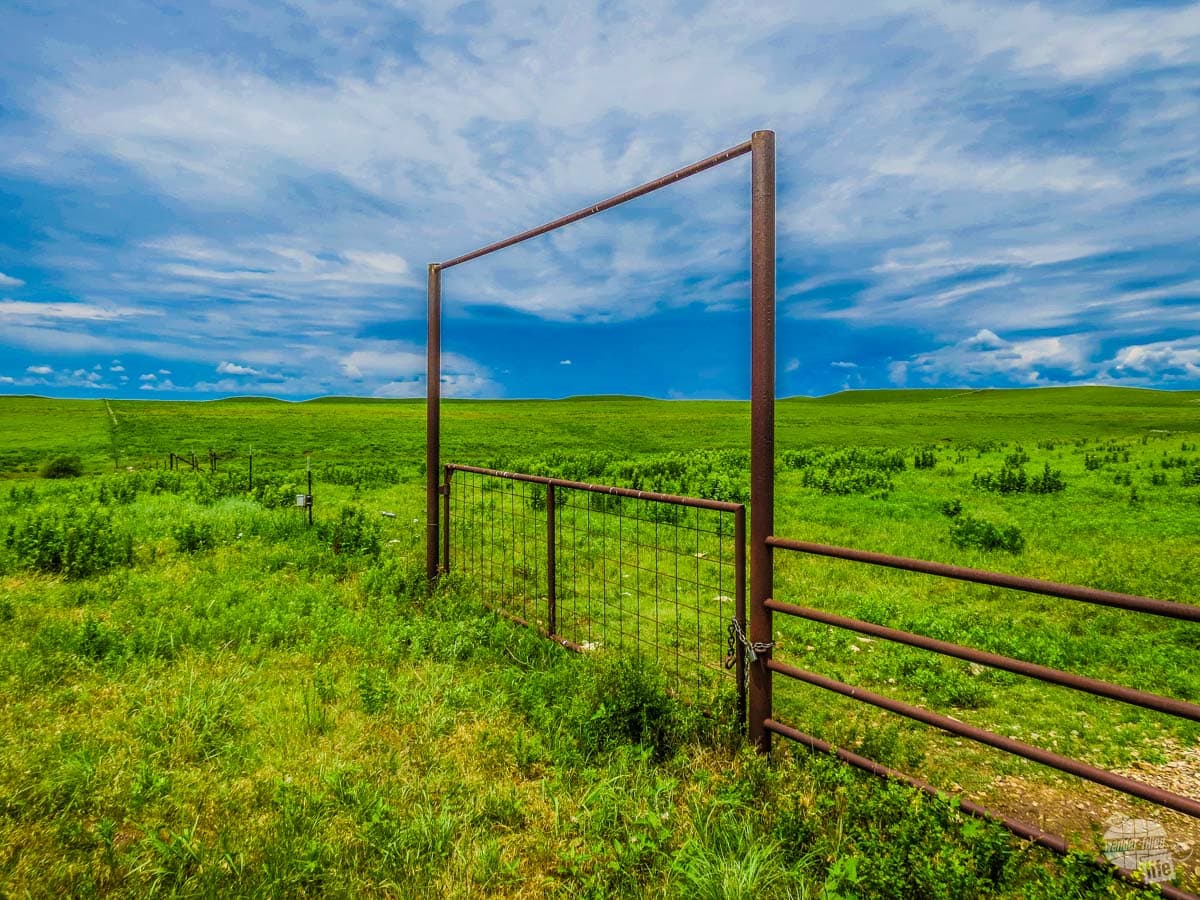
Our trip across the Plains was every bit an experience for us. Not only did we see and learn a lot, we got help out one of our students with the International Thespian Festival in Lincoln, NE.
(Disclaimer: When we link to places where you can buy our stuff or places we stayed, we are using special codes that earn us commissions on the sales at no additional cost to you. Please see our Review Policy for more information.)
Missouri
Southern Missouri has three National Parks sites and we managed to visit two of them on our way West. We stayed at a campground near Branson and then made our way across the state.
Wilson’s Creek National Battlefield
Our first stop was Wilson’s Creek National Battlefield, which was the first major Civil War battle west of the Mississippi. It also saw the first Union general killed in combat. This battle, along with the Battle of Pea Ridge to the south, kept Missouri in the Union during the war.
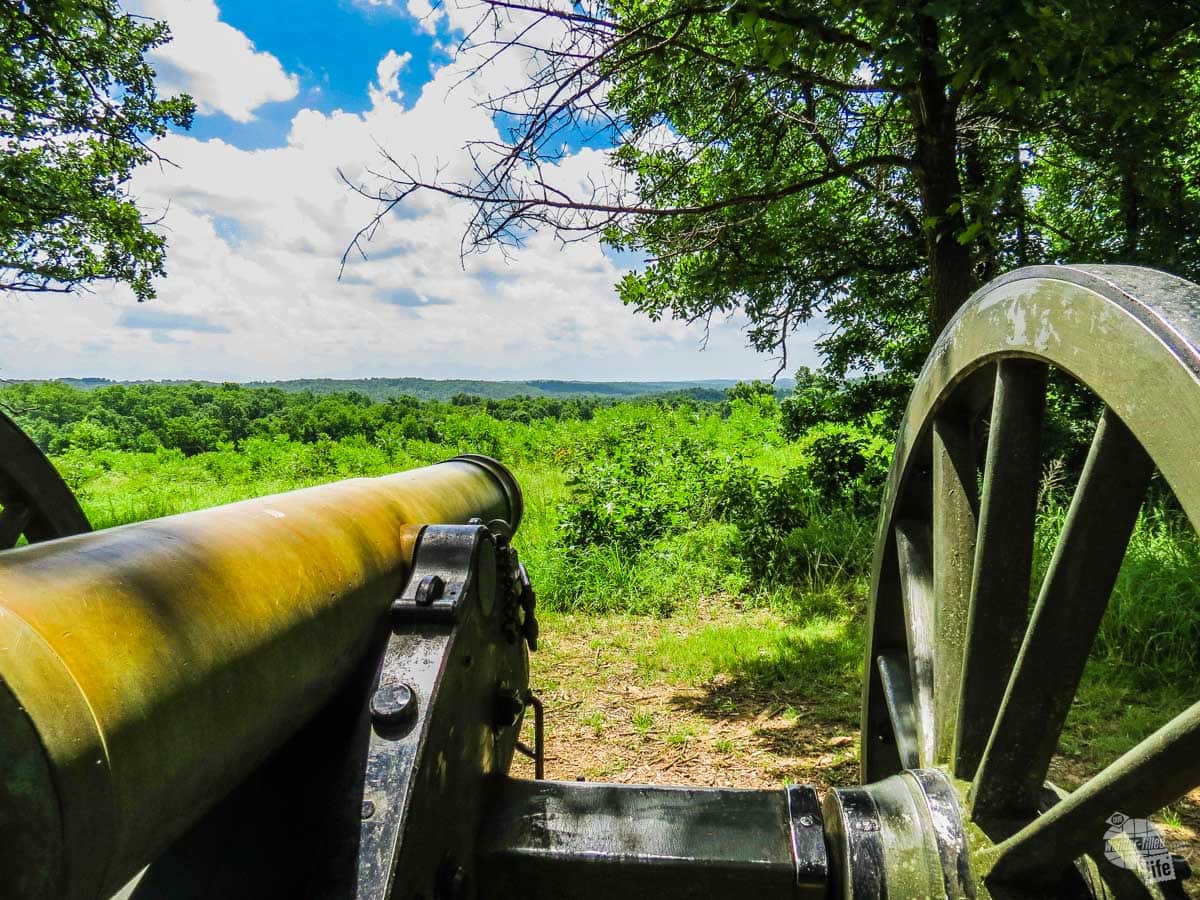
The site itself a driving tour with several stops to get out and look around. But, honestly, the land at a battlefield is just generally just open land. We always make a point to visit the Visitor Center beforehand and, especially, to watch the video on how the battle went before driving the site. We find it adds a lot to our experience.
Plan on spending an hour or two here, more if you want to get out and hike parts of the battlefield.
George Washington Carver National Monument
The next stop was the George Washington Carver National Monument. It is not too far off the Interstate, but feels like the middle of nowhere (of course there wasn’t anything exciting on the Interstate either).

For those not familiar, Carver was born into slavery shortly at some point during the 1860s. He went on to become a professor at the Tuskegee Institute and was a huge proponent of crop diversification in the South to combat soil depletion by cotton. He was particularly famous for his advocation of planting peanuts as a versatile crop that had many uses.
We learned quite a bit more about Carver and his life and there was a short, but nice, trail. This site is a prime reason why we are making a point to visit every National Parks site. We wouldn’t have necessarily gone out of our way to visit this site but we sure learned a lot and enjoyed it!

Plan on spending an hour or so here.
After that, we headed for Miami, OK (pronounced “Miama”) to a Category 2 Hampton Inn. We love redeeming a small number of points for a good night’s sleep, a clean bathroom and a decent breakfast!
Book the Hotel | Read TripAdvisor Reviews
Kansas
We learned one major lesson this summer: Camping in the Plains is a bit of a crapshoot in terms of campgrounds. Sometimes, you can find great, shaded spots. Sometimes, there’s nothing but wide open spaces and a lot of sun beating down on you.
Fort Scott National Historic Site
We arrived at Fort Scott National Historic Site just before lunch. It was overcast, which meant fabulous temperatures at a location that requires walking between multiple buildings. Fort Scott was a military site in the 1840s. The government shut it down and auctioned off in the 1850s. The Union reopened the fort following the beginning of the Civil War.
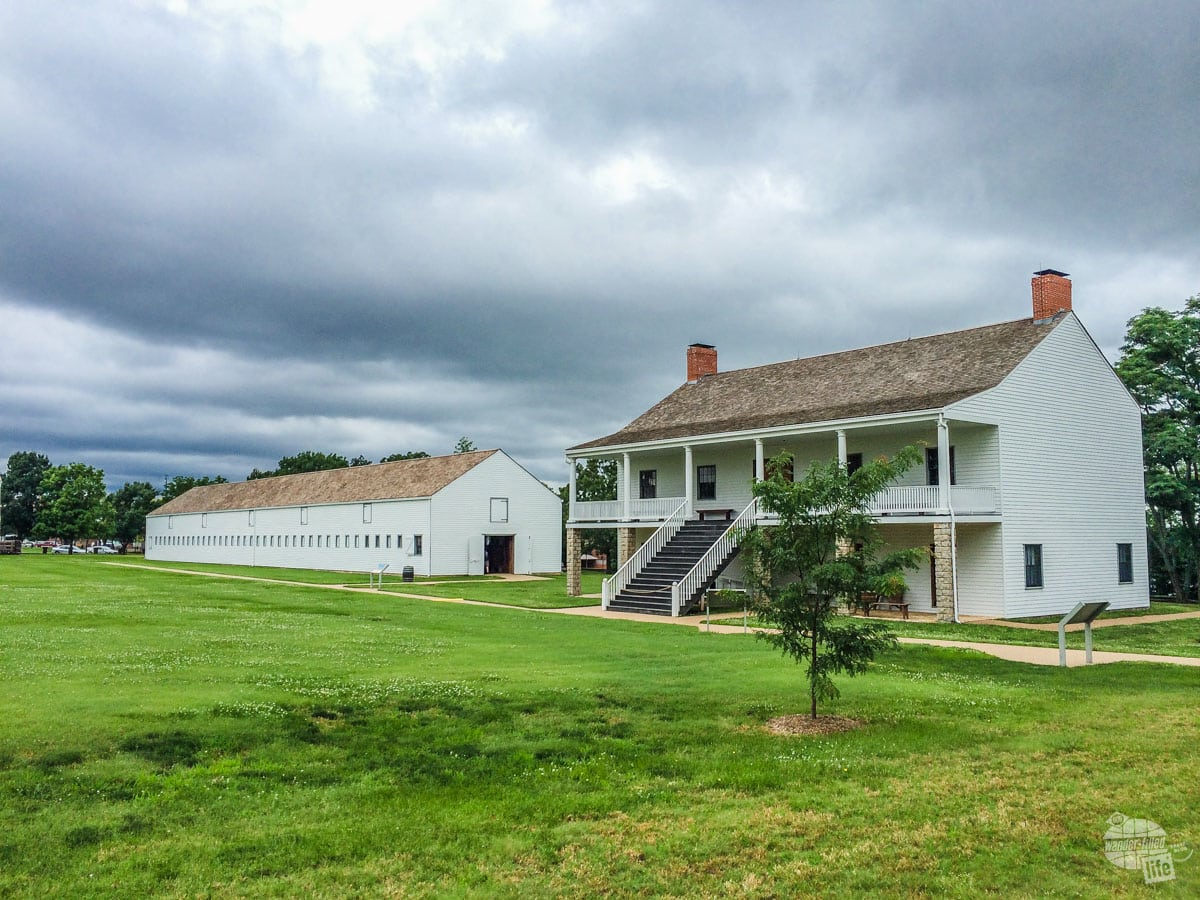
The site consists of restored and reconstructed barracks, stables, officer quarters, hospital, guardhouse (prison) and a few other buildings all built around a small square. The historic downtown is literally right across the street. It is a neat area with lots of history.
Touring the fort takes about an hour.
Campground Mistakes Part 1
From there we drove to Emporia, our “home base” for the next few nights as we visit Tallgrass National Preserve. When we arrived at the campground, we quickly realized we did not want to stay there for three nights.
It wasn’t a bad-looking campground, but it was at the corner of a US Highway and the Kansas Turnpike with lots of road noise and nothing else about it was nice enough to make up for that poor of a location. We generally are pretty good about looking into these kinds of details, so we’re kind of kicking ourselves for this oversight, but we’ll survive.

One thing we have begun to notice is most campgrounds cater to those with RVs rather than tent campers. We understand why but it can be a bit frustrating nonetheless.
We did a little research and realized this was not an easy fix. So, we just did a temporary fix of the Hampton Inn in Topeka for tonight. We will figure out the next two nights tomorrow. Thankfully, we are ready to be flexible and just figure things out as we go!
Book the Hotel | Read TripAdvisor Reviews
The plus side was that it was much easier to fit in dinner with one of Grant’s Army buddies and it was great to be able to spend some time chatting with him.
So, we will enjoy our comfy bed tonight and hot breakfast in the morning and then drive out to Tallgrass Prairie National Preserve and start looking for a place to camp for a night or two. We learned on our last summer road trip in 2012 not to over plan for this exact reason. Allowing flexibility and the opportunity to “fix it” is never a bad thing!
Tallgrass Prairie National Preserve
A partnership with the Nature Conservancy, Tallgrass Prairie National Preserve is an old farm/ranch in the Flint Hills surrounded by some of the last remaining tallgrass prairies in the country. The Flint Hills are scenic and a respite from the flatness that is the rest of Kansas. Still, don’t expect steep inclines or switchbacks here.
The walk around the barn, house, and accompanying buildings is fairly short but we did a bit more exploring on the trails and got in some relatively significant mileage today.
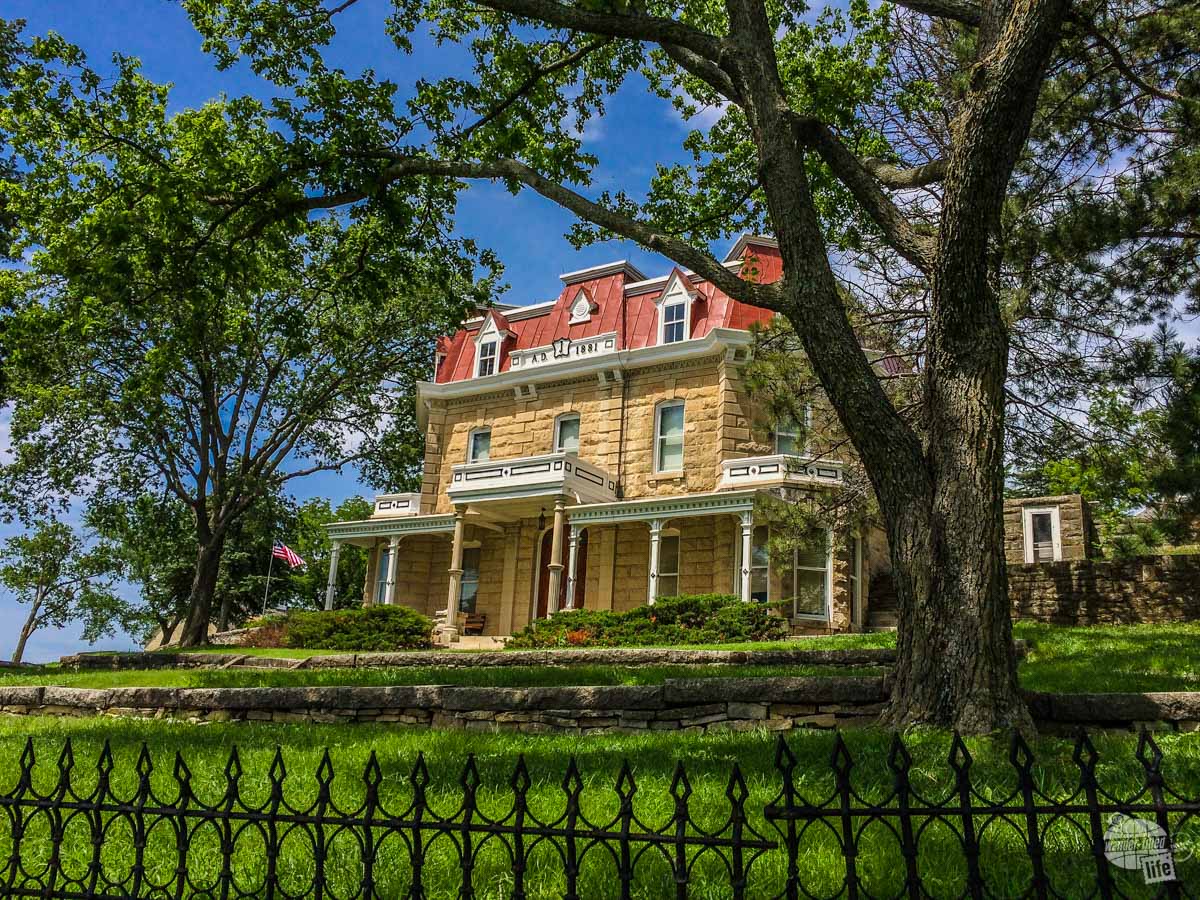
The first hike was about three miles round trip to the old one-room schoolhouse which was operational from the mid-1850s to around 1930. The part that was most interesting was the rules for teachers.
For women, you could not dye your hair, be out of the house from 8 p.m. to 6 a.m. unless it was a school function, no socializing in the ice cream parlor, restricted dating/marriage. For men, the most notable restriction was that you could go on a date only one night a week. If you were active in the church, you could go out two nights a week.
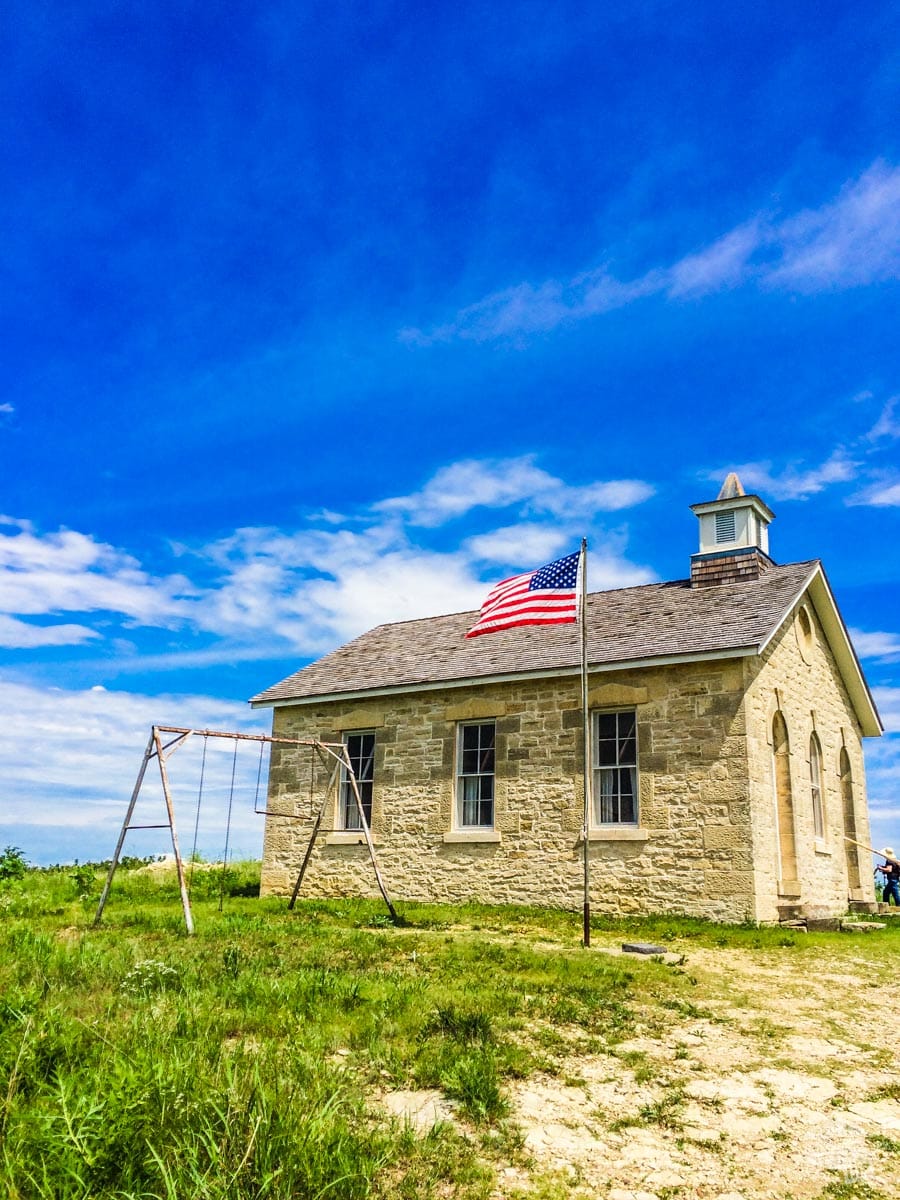
The second hike was almost six miles round trip and went along an old gravel road to a scenic overlook. The trail goes through a large pasture supposedly home to a somewhat aggressive bison herd. Both the map and the rangers cautioned us: be extremely careful and stay far away from the bison.
We figured that we’ve hiked in enough places with bison that it shouldn’t be too big of a deal but we were alert and watching out as we walked. Of course, we didn’t even see a single bison anywhere, even off in the distance. A little disappointing but we know we’ll see plenty if them later in the trip
Plan on spending half a day up to two days, depending on how much hiking you want to do.

A Favorite Campground
We did manage to find an Army Corps of Engineers campground right on Council Grove Lake not far from the Preserve. The sites are nice and well-shaded and the facilities, which include flush toilets and showers, seem to be well-kept. This definitely turned out to be a great alternative to our original plans.
We have found Corps of Engineers campgrounds to be typically good and since most revolve around a nearby dam, you can expect them to be on the water and often shaded.
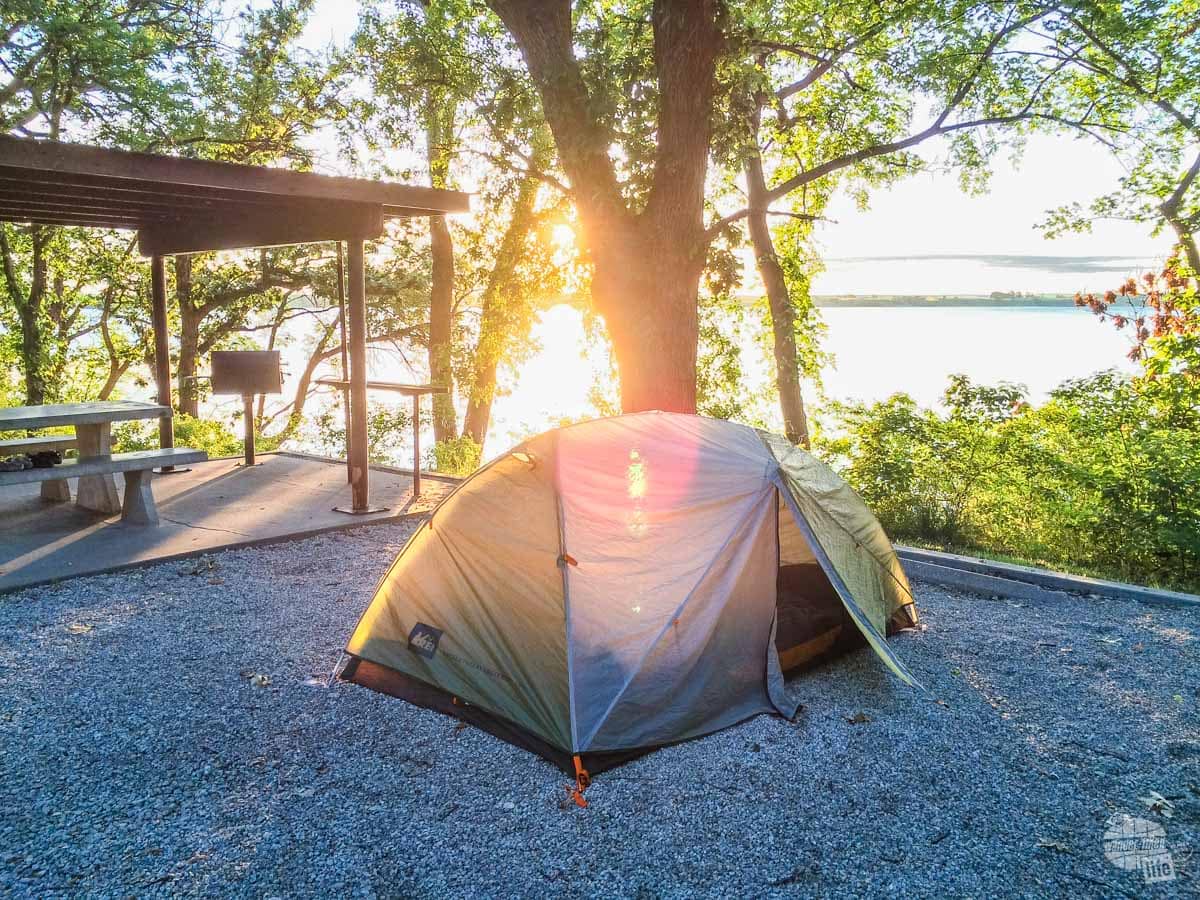
This morning, we woke up to a lovely sunrise over the lake! We truly are blessed and appreciative of the time that we have to take the trips and see everything that we do.
Fort Larned National Historic Site
Fort Larned National Historic Site is the best-preserved military post on the Santa Fe Trail. Despite the fact that it was only operational for about 20 years, the fort housed many different units, most notably the 10th Cavalry, better known as the Buffalo Soldiers. Fort Larned is very similar to Fort Scott but more remote and basic.
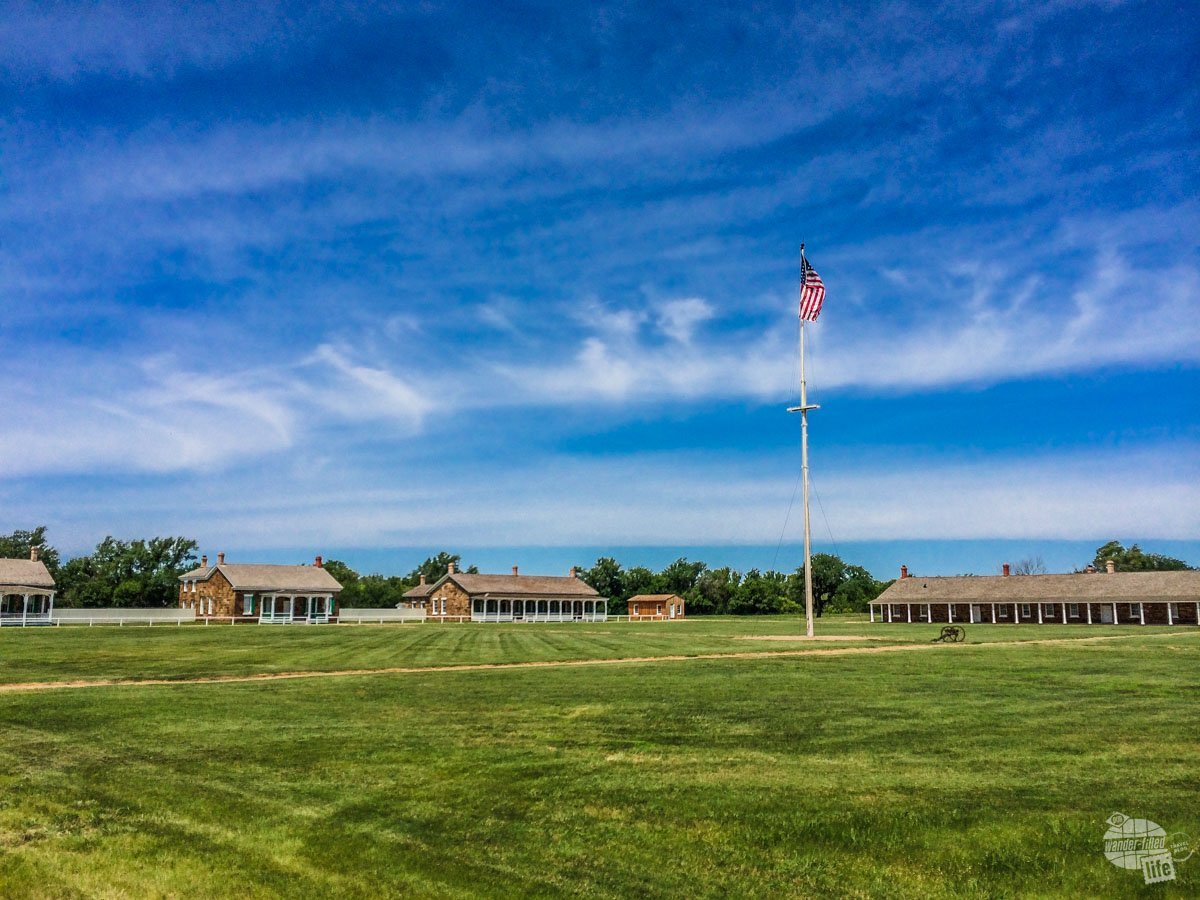
You will find basic structures typical of a frontier fort. What makes these forts interesting is the history they represent rather than the sites themselves.
Plan on spending about an hour touring the fort.
Nicodemus National Historic Site and Campground Mistakes Part 2
From there we drove north and spent the rest of the afternoon looking for a place to camp. Our original destination (a KOA) did not have any shade and was right next to an interstate, so we decided to continue driving on to the next site and keep looking for a campground.
That led us to our next stop, Nicodemus National Historic Site. Former slaves relocating from the South established Nicodemus after the Civil War in the 1870s. It is the oldest and only remaining all-black town west of the Mississippi River.
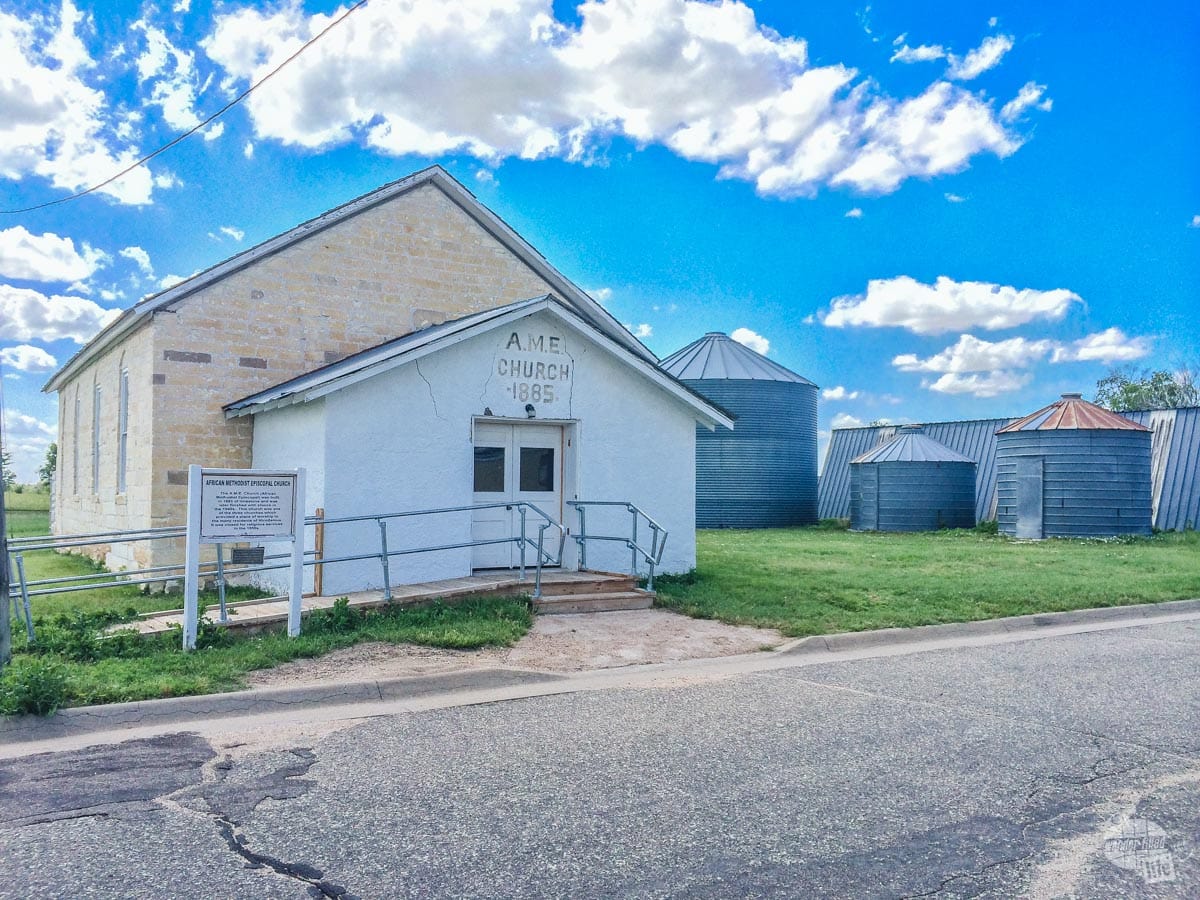
Though to say it remains a town is somewhat generous. There are only 25-30 people who live there. We did not see any sort of services (gas, groceries) within 15 miles in either direction. It is definitely very remote. But, from what we learned in the visitor center, the folks who live there are very proud of the town, its history, and what it represents.
The official site consists of a few historic buildings (hotel/post office, 2 churches, and the town hall), most of which are closed up. While this stop certainly will not be a highlight of our trip, it was very educational!
Be sure to watch the video, then take some time to either walk or drive through town.
From there, it took us three state parks before we found one with good campsites for tent camping in the summer… ie shaded!
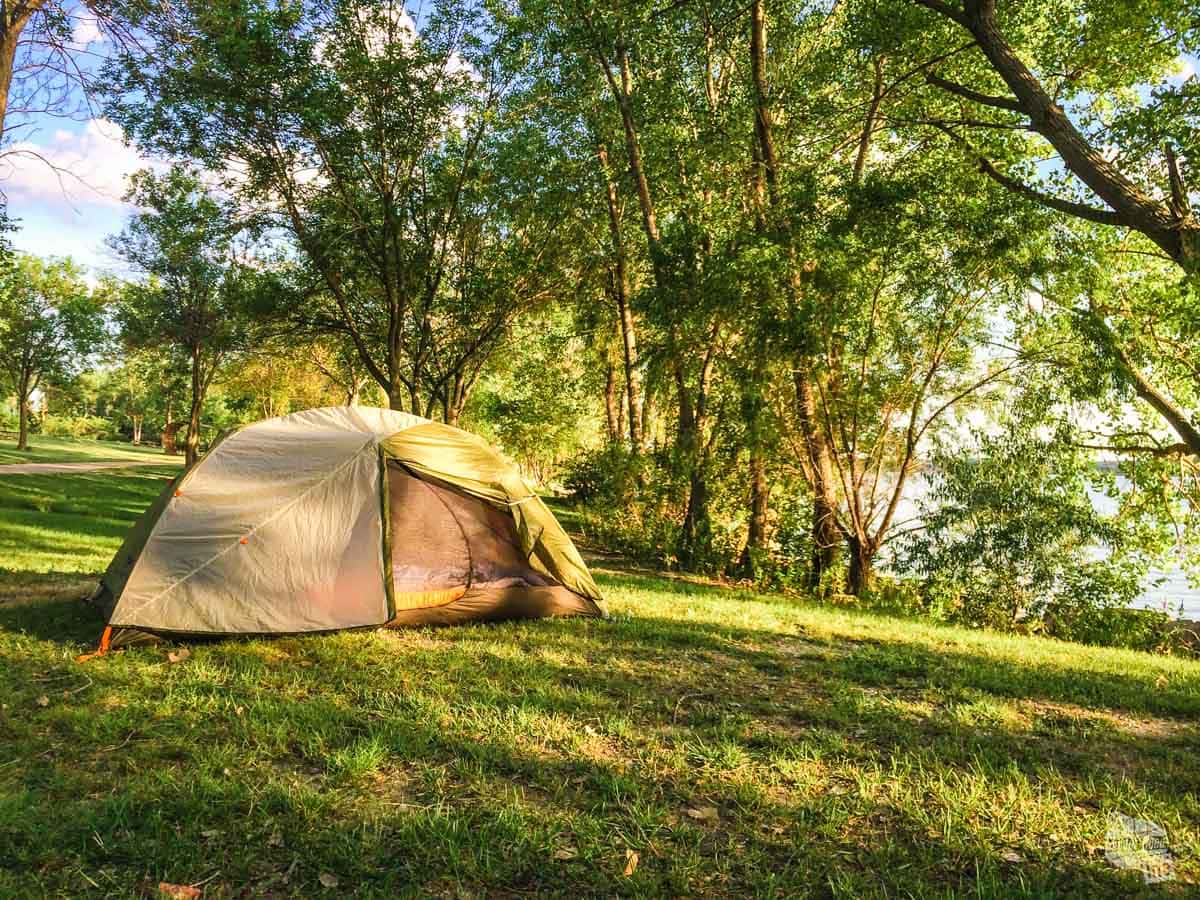
Nebraska
While Nebraska and Kansas often get lumped together in terms of terrain and vegetation, we find Nebraska has quite a bit more variety and more in the way of trees than Kansas. We also like the ruggedness of western Nebraska as you approach the Wyoming border.
Homestead National Monument of America
Located in southeastern Nebraska, Homestead National Monument of America tells the story of one of the most important laws which completely transformed the West.
The Homestead Act of 1862 offered free land (160 acres) for anyone willing to live on it, farm it, and build a home. Through this Act, the government gave away 270 million acres of land. Of that, only about 40% of the folks actually received the title for the land – which required five years of “homesteading.”
The NPS site is at the location of one of the very first parcels given away through this act. There’s not much to see in the land but they have a nice “heritage center” (not sure why it isn’t just called a visitor center, but, I guess it doesn’t really matter). They have displays explaining the process of homesteading, the equipment used on the farms “back in the day” as well as pictures and stories from various homesteaders.
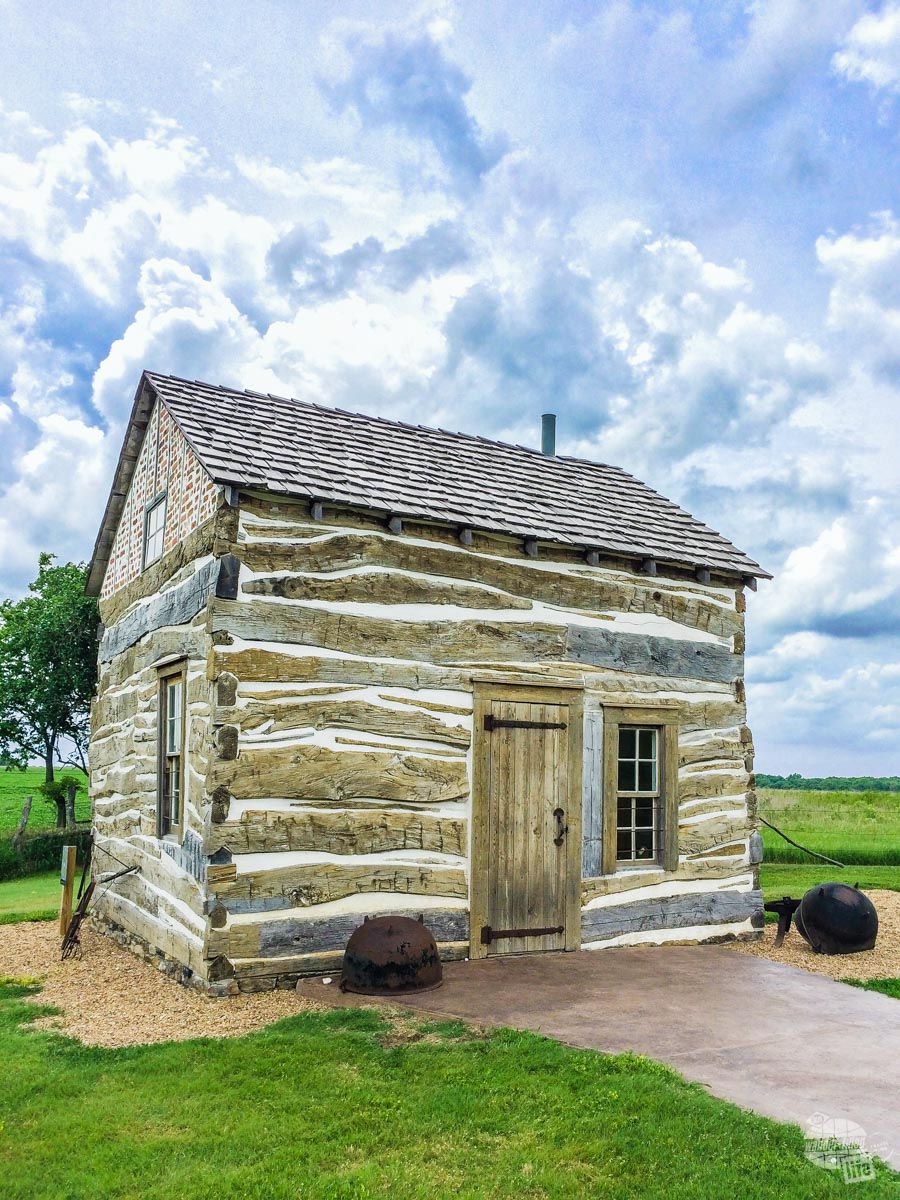
We particularly enjoyed the story of the last homesteader who got his land in Alaska in 1978. He cultivated it for the required five years, but it took another five years after that to actually get the title. Our guess is that no one really knew what it was when the request came in! He ended up selling his land in 1993 and that was the end of homesteading in America.
Visiting NPS sites, we hear a lot about homesteaders, so it was really good to learn a little bit more about the whole thing. You have to really want to see this site. Plan on spending an hour or two checking out all of the exhibits.
Lincoln and the International Thespian Festival
From Homestead NM, we headed into Lincoln. We will be here for a couple of days working with the Georgia All-State show, In the Heights, which was performing at the International Thespian Festival on Saturday night.
We’ve been helping out with the Georgia All-State show: In the Heights. One of our upcoming seniors was in the show and we were asked to help out with the set.
We spent a week last summer building the set, several weekends throughout the year helping with finishing touches, set assembly/disassembly and for the performance at the state Thespian Convention. Now, we are in Lincoln to do it all one last time for the International Thespian Convention.

We unloaded set on Friday afternoon and assembled the set on stage Saturday afternoon. Then the kids had two performances back-to-back Saturday night. We then disassembled the set and reloaded it back onto the trailer. We didn’t get back to the dorms until almost 2 a.m., so it was a long day! Both performances went really well and the kids had a blast, so that makes it worth it!
The festival is a week-long conference held at the University of Nebraska. Kids stay in dorms. Official chaperones also stay in dorms. Yes, we’re talking the traditional bathroom down the hall kind of dorms.
Thankfully, they have separate housing for the “support staff,” the folks that are only here for a couple of nights, like us. We get the fancy, suite-style dorms… one living room/kitchen/bathroom for four people, with two bedrooms.
Other than the fact that the beds were really uncomfortable and were two twin beds, the accommodations actually weren’t bad, especially since there were just two of us in our suite. We got free meals in the campus cafeteria. Food was ok. Nothing to get excited about, but decent options. And we didn’t pay for it, so that’s always good.
Agate Fossil Beds National Monument
After a brief stop at Chimney Rock National Historic Site (which is run by the State of Nebraska), we headed to the town of Scottsbluff to explore two sites just doused in history.

First up, Agate Fossil Beds National Monument. This was the site of a significant fossil find including a “dogbear” with underground dens, a six-foot-tall pig-like animal and a pony-sized rhinoceros.
The theory is that the spot where the fossils were found was a watering hole and as the food sources (vegetation) was eaten up close to the water, animals had to travel farther between the two until they eventually couldn’t make the trek.
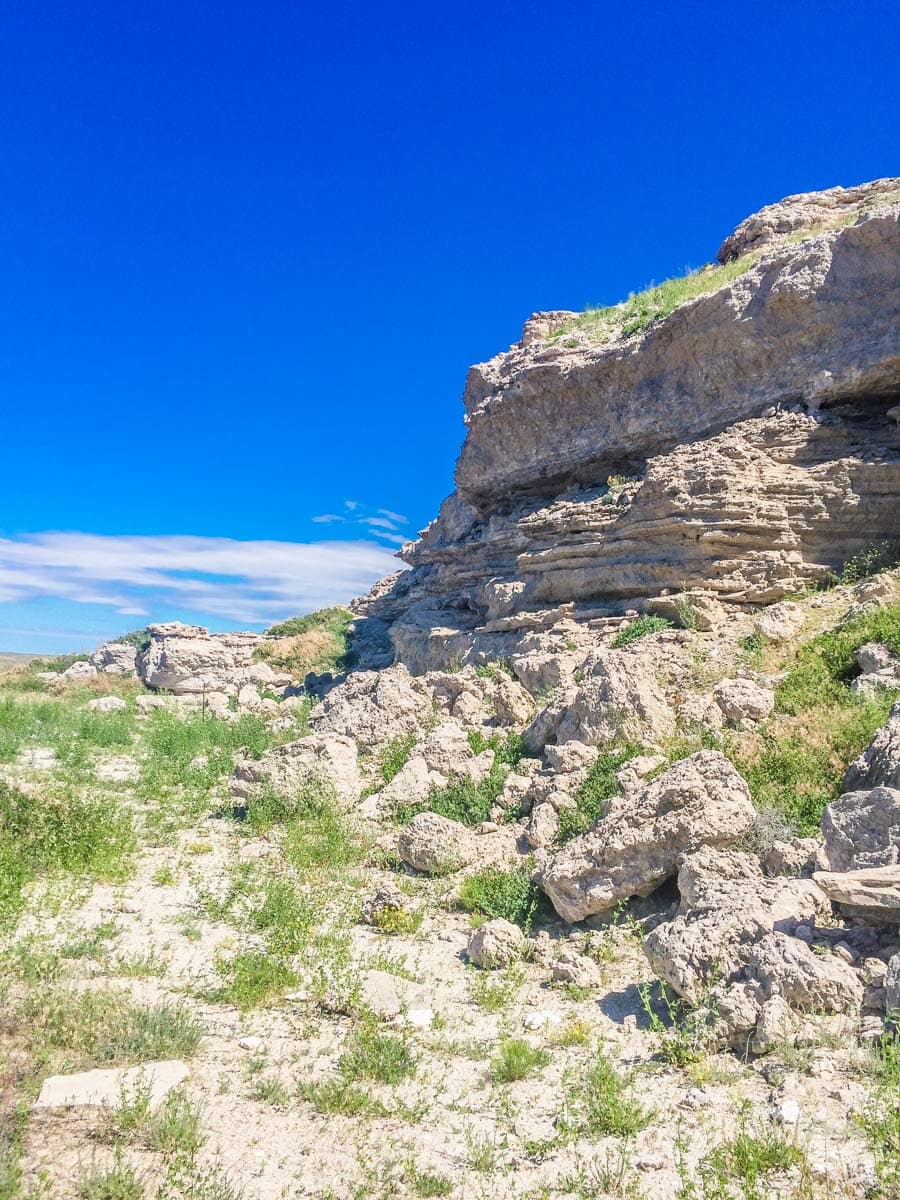
Another interesting bit about this location is the owner of the ranch where the fossils were found. He was an Army scout, a homesteader and was highly regarded by several Native American tribes. He was friends with Red Cloud (a great Lakota chief) and received many gifts from the natives which were on display.
Plan on spending two to three hours here, at least.
Scotts Bluff National Monument
One of the more unique rock formations along the Oregon Trail, Scotts Bluff National Monument helps tell that tale of the pioneers headed West.
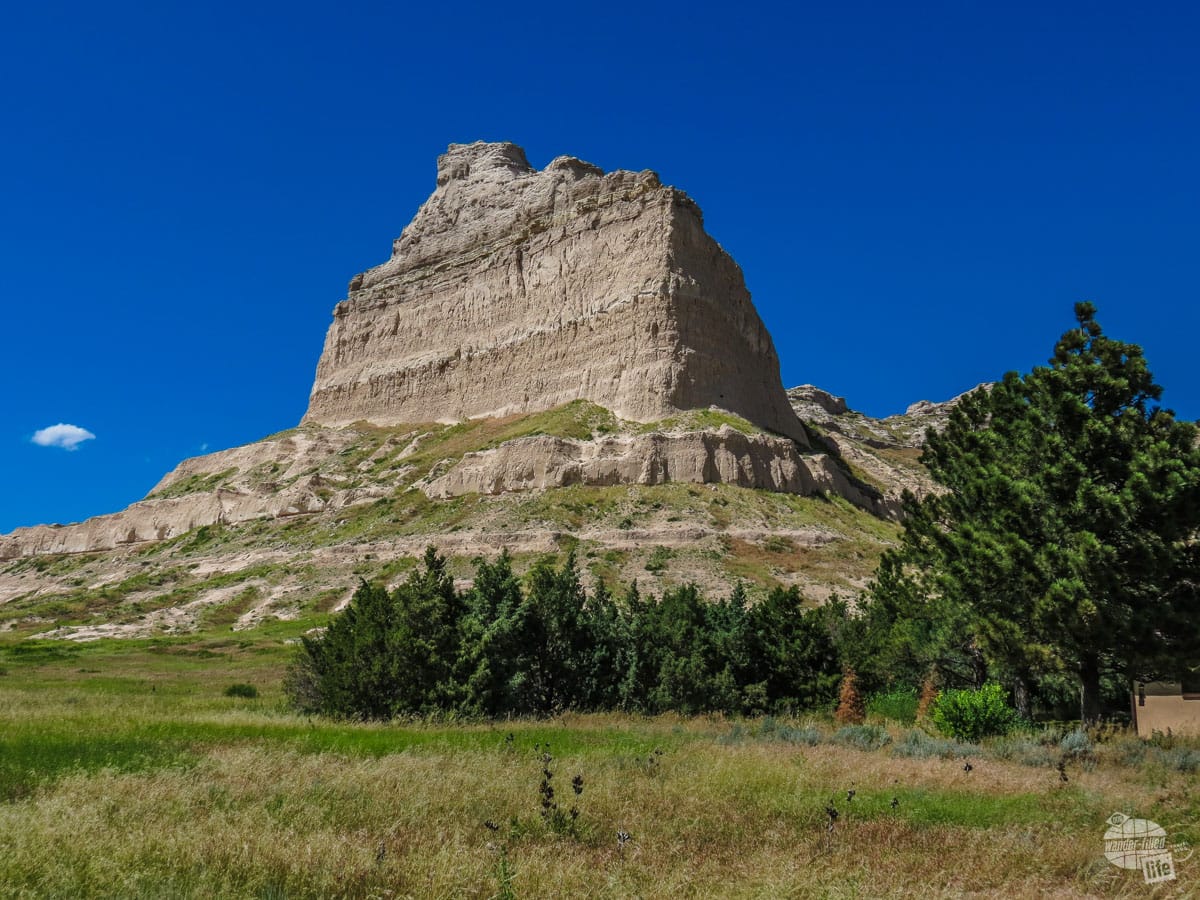
It was the first terrain that wasn’t just grassy plains that the folks heading west along the Oregon Trail encountered. We took the shuttle to the top, which offered spectacular views of the surrounding landscape and towns, then hiked down. Walking down is a lot easier than hiking up it! We also walked on a portion of the actual Oregon Trail.

I can’t even imagine making this journey across the Plains in a covered wagon! And, just to clarify, very few people actually ride in the wagons. The wagons really were just for all the gear. Most of the people walked alongside. We learned it generally took six to eight weeks to make it this far (leaving from Independence or St. Joseph, MO) and this was just the first 1/3 mark of their journey! It really makes us appreciate the transportation we have now!
Plan on spending at least half a day here, more if you plan on hiking up.
Wyoming
While I certainly wouldn’t classify Wyoming as a Plains state, there are certain parts of eastern Wyoming that could not be classified as anything but.
Fort Laramie National Historic Site
About an hour from Scotts Bluff NM is Fort Laramie National Historic Site.
Fort Laramie started out as a trading post at the confluence of the Laramie and North Platte rivers, eventually becoming a military fort.
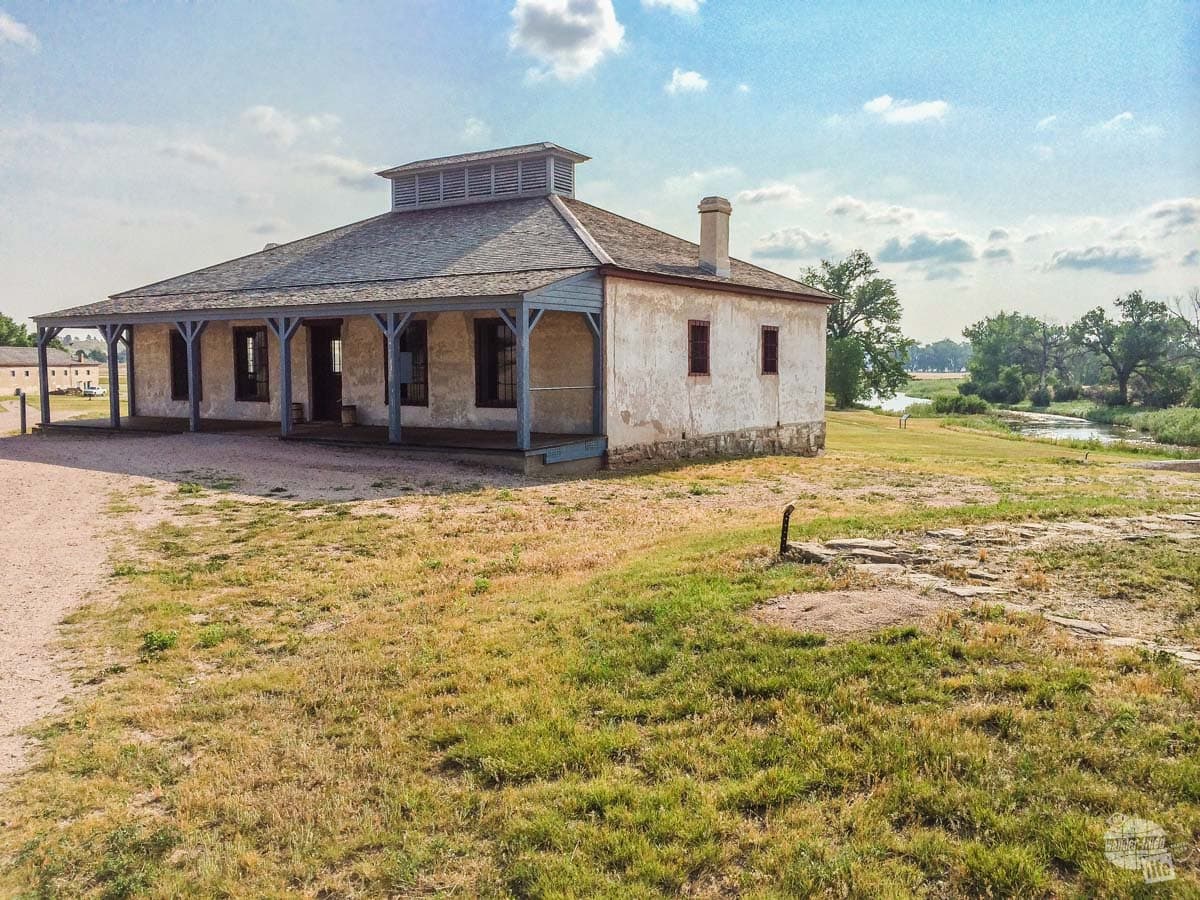
The fort served as an important supply post on the Oregon Trail, the economic hub of the area and a staging base for soldiers during the Indian Wars. It was also the site of the contentious 1851 Treaty of Fort Laramie.
One of the most heartbreaking parts of studying the American West is the treatment of the native tribes. It’s impossible to visit these sites and not see the impact on the tribes. That’s one reason why it is so important to see the sites for yourselves: to have that personal connection to our collective history and to learn from it.
Plan on spending about an hour here.
Final Thoughts on Crossing the Plains
While for most folks, the Plains are just places to “get through” on the way West to visit the natural beauty found in Yellowstone, Montana or Colorado, there’s a lot to see and love on the way.
You can easily spend several days stopping at sites along the way and it can easily become a great way to break up an otherwise long and boring drive.
Travel Resources
What do you use to find a flight?
We use Skyscanner to find deals on flights. Skyscanner has a great interface and compares tons of airlines for the best pricing and routing. That said, it does not always have every airline and some airlines will have better deals on their website. Still, Skyscanner is a great place to start.
Click here to search for a flight.
What do you use to find a hotel?
We typically stay at Hilton properties, so we use the Hilton website. You can find good Hilton Honors discounts or AAA discounts for a hotel there. We make great use of our free night certificates from our Hilton Honors American Express.
Click here to book a Hilton property.
If there are no Hilton properties available, we use TripAdvisor to read reviews and book the hotel. We find we can get the best price that way.
Click here to search for a hotel.
We recently partnered with Stay22 to add interactive maps to each of our destination posts. This will allow you to see a plethora of hotels and vacation rentals all in one responsive map of the area.
What if I need more space than I can get at a hotel?
We use Vrbo for the times when we have rented a cabin for a weekend getaway, like this cabin in Townsend, TN, or needed to rent a house for a large family vacation. We had a great experience with them in terms of refunding deposits when COVID hit and will continue to use them.
Click here to search for a vacation rental.
Who do you use for rental cars?
As a general rule, we book with Hertz for rental cars. We have had nothing but good experiences with them. Plus, we really like unlimited mileage and not worrying about crossing state lines. We have even rented from Hertz overseas in both Slovenia and Croatia.
Click here to book a rental car.
How about booking a cruise?
We have found some amazing prices for booking a cruise through Cruise Direct. We have saved a lot of money on our cruises compared to what we found elsewhere, making a last-minute Bahamas cruise even cheaper.
Click here to book a cruise.
What if I want to rent an RV?
We highly recommend Outdoorsy for RV rentals. We rented a camper van for a week to visit Rocky Mountain National Park for the elk rut and Custer State Park for the Buffalo Round-Up and had a blast. The program was easy to use and we really enjoyed the freedom of having a camper van for that trip.
Click here to rent an RV.
What do you use for booking tours?
We don’t often book tours. Typically, we like to do stuff on our own. That said, there are some experiences you can’t have any other way. So, when we do want to book a tour, we always check Viator first.
Click here to book a tour.
Do you use anything to get discounts on the road?
We make extensive use of both Good Sam and AAA on the road. Good Sam is normally regarded as a discount card for RVers at campgrounds and Camping World but anyone can use the 5 cents off a gallon at the pump at both Pilot and Flying J.
Click here to get a Good Sam membership.
We have had AAA as long as we have been married and it has more than paid for itself in discounts at hotels, aside from the peace of mind of having roadside assistance. Add in paper maps and the ability to get an international driver’s license and it is more than worth it for any traveler out there.
Click here to get a AAA membership.
